
A list of prehistoric sea creatures that inhabited the world’s oceans before, during, and after the age of the dinosaurs. Read on to discover amazing prehistoric ocean animals such as plesiosaurs, ichthyosaurs, pliosaurs, mosasaurs and ammonites.
Index
You can see a list of books on prehistoric animals on this page: Prehistoric Animal Books
Introduction
Dinosaurs may be the best-known prehistoric animals, but despite dominating the land during the Mesozoic Era, they never adapted to life in the ocean.
Visit our main dinosaur page to discover everything you ever wanted to know about dinosaurs: Dinosaurs – The Complete Guide
So-called “sea-dinosaurs” such as plesiosaurs and mosasaurs may have been reptiles, but they were not dinosaurs, each forming their own, separate branch in the reptile family tree.
Below is a list of prehistoric ocean animals from before, during and after the Mesozoic Era. Most of the animals on the list are reptiles, but other notable prehistoric sea creatures, including fish and mammals, have also been included…
Ammonite

- Class of animal: Cephalopoda
- Family: Ammonoidea
- When it lived: Devonian to Cretaceous (approximately 400 to 66 million years ago)
- Where found: Worldwide (fossils have been found on every continent)
- Size: Ranged from a few centimeters / inches to over 2 meters / 6.5 ft. in diameter
Ammonites were marine mollusks with spiral shells divided into chambers. Ammonites were cephalopods, and as such, related to modern squids, octopuses, and cuttlefish.
These free-swimming predators preyed on smaller marine creatures, and may have been able to squirt ink at potential predators, just like modern cephalopods. Their extinction coincided with the mass extinction event that also wiped out the dinosaurs.
Abundant in prehistoric oceans, ammonites are used as index fossils – their widespread presence and rapid evolution allow geologists to accurately date and correlate rock layers across different geographic regions.
You can find out more about ammonites on this page: Ammonite Facts
Archelon
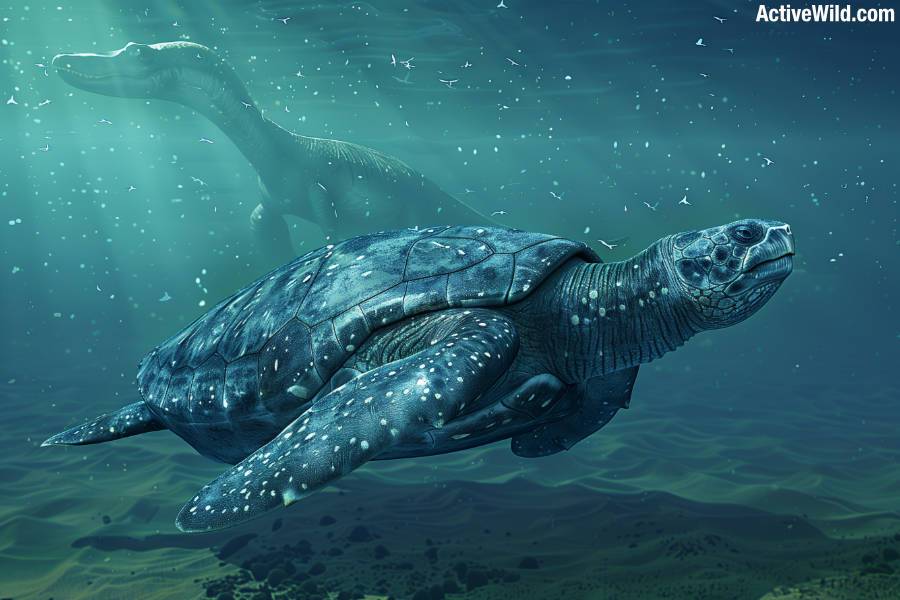
- Class of animal: Reptilia (Turtle)
- Family: Protostegidae
- When it lived: Late Cretaceous (about 80 to 74 million years ago)
- Where found: North America (fossils mainly found in the Western Interior Seaway)
- Size: Up to 4.6 meters (15 feet) in length and about 3.3 meters (11 feet) flipper span
The largest turtle ever known, Archelon was longer than the combined height of two men.
This prehistoric sea turtle had a leathery carapace – similar to that of the living leatherback turtle – rather than a hard shell, and elongated, paddle-like flippers for swimming. Despite similarities between the two, Archelon was not related to the leatherback sea turtle.
The large size and powerful flippers of Archelon made it a strong swimmer, enabling it to migrate over long distances in the ocean. It had powerful jaws for crushing prey, and likely fed on mollusks, crustaceans, and jellyfish.
Basilosaurus
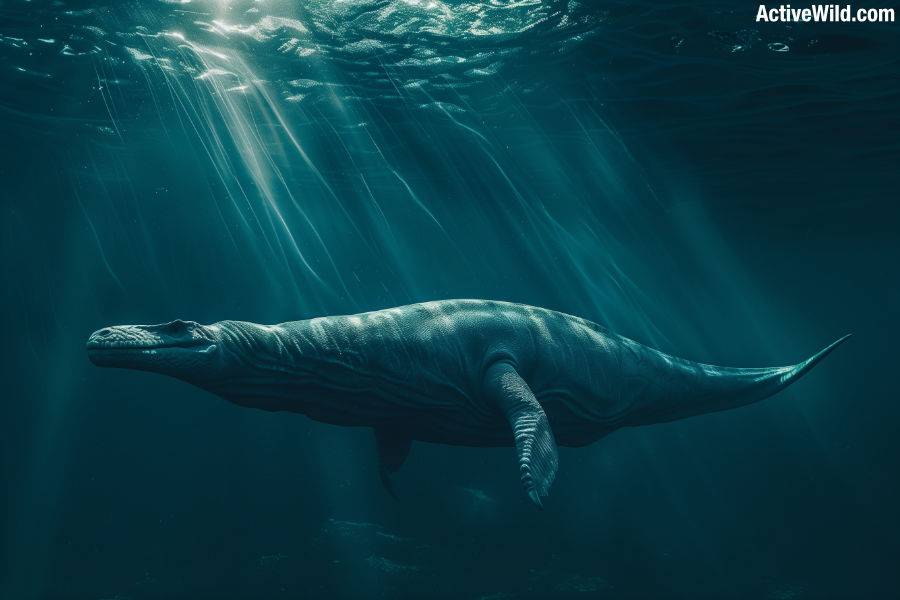
- Class of animal: Mammalia (Cetacean)
- Family: Basilosauridae
- When it lived: Late Eocene (about 41 to 33.9 million years ago)
- Where found: North America, Northern Africa, West Asia
- Size: Approximately 15 to 20 meters (49 to 66 feet) in length
Basilosaurus was an early whale with a long, slender body resembling that of a snake or eel.
Despite having “saurus” as part of its name (saurus comes from the Greek for “Lizard” and usually denotes a reptile), Basilosaurus, like all whales, was a mammal. (At the time of its naming, this large prehistoric sea creature was thought to have been a reptile.)
Basilosaurus was likely a top predator in its marine environment, feeding on fish, sharks, and possibly other marine mammals. Its elongated body and large size made it a formidable hunter.
Cretoxyrhina
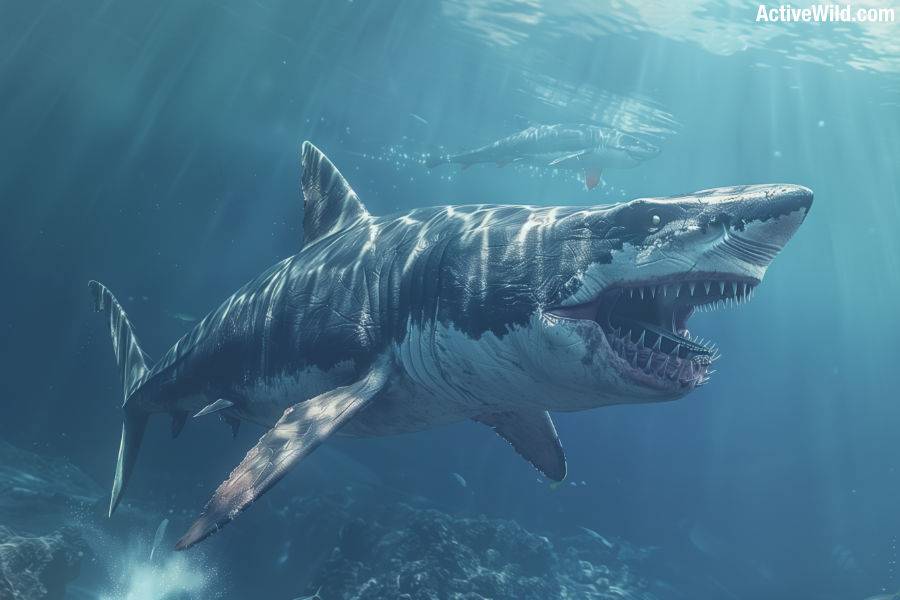
- Class of animal: Chondrichthyes (Shark)
- Family: Cretoxyrhinidae
- When it lived: Late Cretaceous (about 100 to 82 million years ago)
- Where found: Worldwide (fossils found in North America, Europe, and Africa)
- Size: Up to 8 meters (26 feet) in length
Cretoxyrhina was a large shark from the Cretaceous Period. Like living sharks, it has a robust body, powerful jaws, and sharp, serrated teeth designed for slicing through flesh.
This prehistoric shark was discovered in East Sussex, England, by paleontologist Gideon Mantell. It was later given the name Cretoxyrhina mantelli in honor of the scientist. The species is also known as the Ginsu shark.
Cretoxyrhina was an apex predator in its ecosystem, preying on a variety of marine animals, including fish, other sharks, and marine reptiles. Its fossilized teeth and vertebrae are found in Late Cretaceous marine deposits.
Dakosaurus
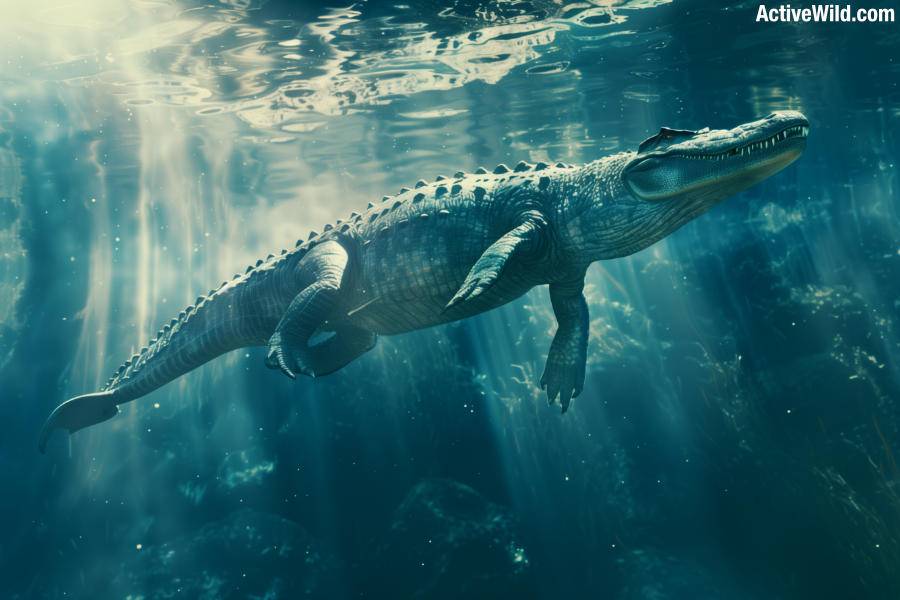
- Class of animal: Reptilia (Crocodylomorpha – a group that contains crocodiles and related animals)
- Family: Metriorhynchidae
- When it lived: Late Jurassic to Early Cretaceous (about 157 to 137 million years ago)
- Where found: Europe and South America
- Size: Up to 5 meters (16 feet) in length
Dakosaurus was a marine crocodyliform with a robust body, elongated jaws, and serrated teeth resembling those of theropod dinosaurs.
Unlike modern crocodiles, Dakosaurus was fully adapted to marine life with paddle-like limbs and a tail fluke for swimming. Scientists are unsure whether it laid eggs on land like today’s sea turtles, or conducted its entire life cycle at sea.
With its powerful jaws, Dakosaurus was probably a top predator in its oceanic environment, hunting fish and other marine reptiles. Its fearsome appearance has earned it the nickname “Godzilla”.
Dunkleosteus

- Class of animal: Placodermi (an extinct group of prehistoric fish)
- Family: Dunkleosteidae
- When it lived: Late Devonian (about 382 to 358 million years ago)
- Where found: North America, Europe, and Morocco
- Size: Up to 10 meters (33 feet) in length
Dunkleosteus was one of the largest and most fearsome prehistoric fish, with a heavily armored head and thorax. Its jaws were equipped with sharp, bony plates that acted like shears, capable of cutting through the toughest prey.
This fearsome prehistoric fish is thought to have had one of the strongest bite forces of any known animal. Estimates of the maximum length of Dunkleosteus range from around 5 m / 16.5 ft to up to 10 m / 33 feet.
Dunkleosteus lived during the Devonian Period, millions of years before the arrival of the dinosaurs.
Likely an apex predator in its marine environment, Dunkleosteus fed on other fish and marine animals. Its powerful bite and massive size would have made it a dominant force in the Devonian seas.
Elasmosaurus
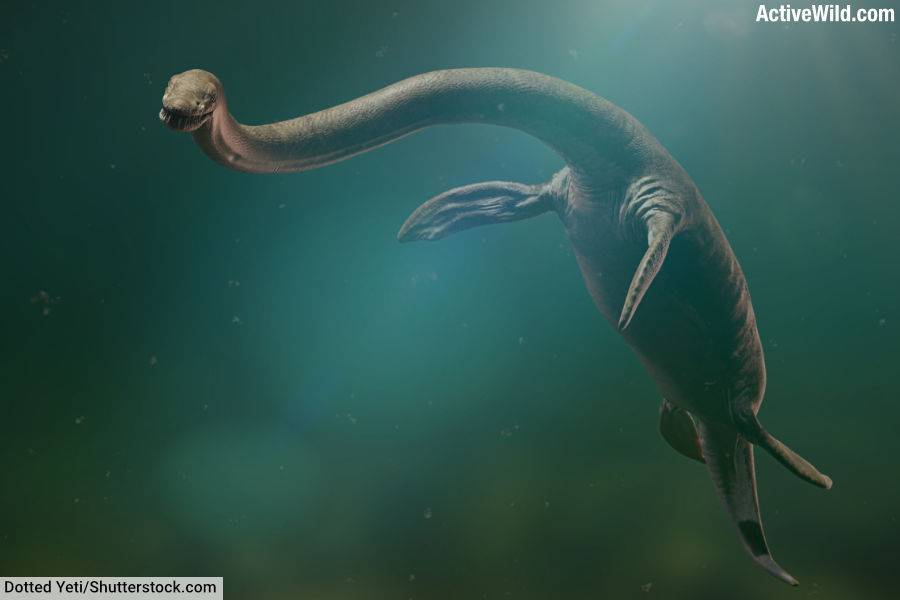
- Class of animal: Reptilia (Plesiosaur)
- Family: Elasmosauridae
- When it lived: Late Cretaceous (about 80.5 million years ago)
- Where found: North America (notably in the Western Interior Seaway)
- Size: Up to 14 meters (46 feet) in length, with the neck alone being about 7 meters (23 feet) long
Elasmosaurus was a long-necked marine reptile known for its highly-elongated neck, which made up nearly half of its total body length. It, and the related Albertonectes, are the longest-necked animals that ever lived.
Like other long-necked plesiosaurs, Elasmosaurus had a small head, large flippers, and a streamlined body, adapted for swimming. It likely fed on small fish and invertebrates, using its elongated neck to sweep through schools of fish or to ambush prey.
Helicoprion
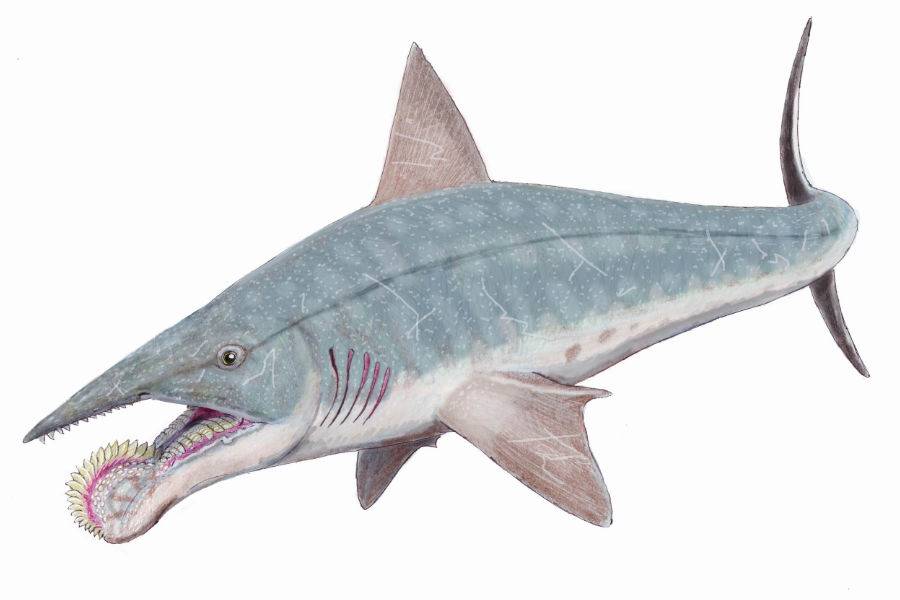
- Class of animal: Chondrichthyes (Cartilaginous fish)
- Family: Helicoprionidae
- When it lived: Early Mid-Permian Period (about 290 to 270 million years ago)
- Where found: Worldwide (fossils primarily found in North America, Eastern Europe, Asia, and Australia)
- Size: Estimated up to 8 meters (26 feet) in length
Helicoprion was a cartilaginous fish known for its unique spiral jaw, which housed a whorl of serrated teeth. This “tooth-whorl” was located in the lower jaw and likely functioned to slice and crush its prey, which included soft-bodied animals such as cephalopods.
With a torpedo-like body and large, forked tail, Helicoprion was likely a fast-moving predator of the open oceans.
Ichthyosaurs
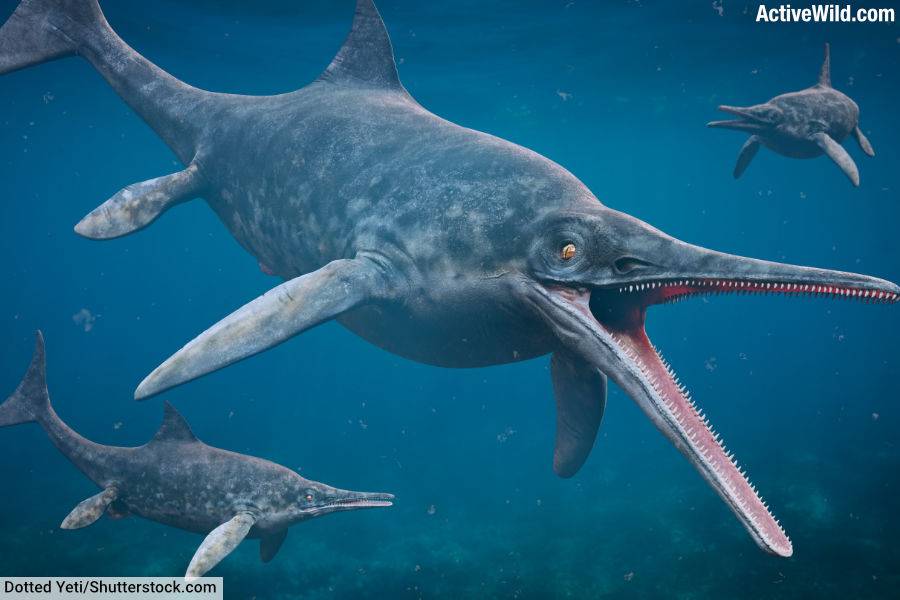
- Class of animal: Reptilia
- Family: Ichthyosauridae (and other related families within Ichthyosauria)
- When it lived: Early Triassic to Late Cretaceous (about 250 to 90 million years ago)
- Where found: Worldwide (fossils found in North America, Europe, Asia, and Australia)
- Size: Ranged from under 1 meter (3 feet) to over 20 meters (66 feet) in length, depending on the species
Ichthyosaurs were a group (the order Ichthyosauria) of marine reptiles that resembled modern dolphins and fish, with streamlined bodies, elongated snouts, and large eyes. They were highly adapted to life in the ocean, possessing strong, paddle-like limbs and tails for efficient swimming.
The name “Ichthyosaurs” means “fish lizard”. The resemblance of Ichthyosaurs to living fish and dolphins is an example of convergent evolution – the phenomenon of unrelated animals developing similar characteristics.
Ichthyosaurs were likely top predators, feeding on fish, squid, and other marine organisms. They are known for giving live birth, as evidenced by fossilized remains of pregnant individuals.
One of the best-known ichthyosaurs was Ichthyosaurus (see below), which lived during the Early Jurassic. Ichthyosaurus went extinct in the Jurassic Period, but other types of ichthyosaurs lived almost to the end of the Cretaceous Period.
Ichthyosaurus
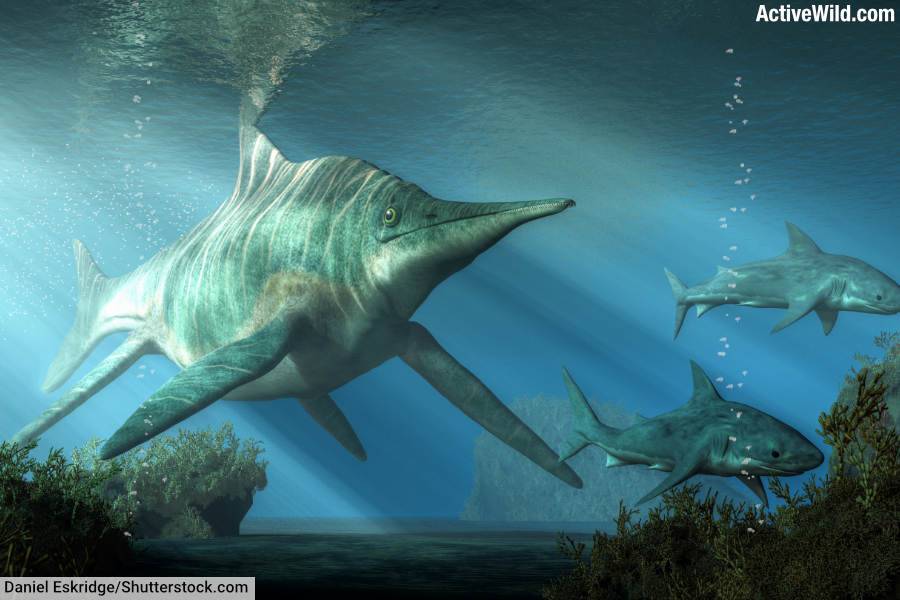
- Class of animal: Reptilia (Ichthyosaur)
- Family: Ichthyosauridae
- When it lived: Early Jurassic (about 200 to 190 million years ago)
- Where found: Europe (notably in England and Germany)
- Size: Around to 3 meters (10 feet) in length
Ichthyosaurus was a genus of ichthyosaur that had a fish-like body, large eyes, and a long, pointed snout filled with conical teeth. It was an agile swimmer, well-adapted to hunting fish and squid in the early Jurassic seas. Its large eyes suggest it had good vision, possibly for hunting in low-light conditions.
Fossil evidence shows that Ichthyosaurus gave birth to live young, with some specimens preserving embryos within the body. The genus is one of the best-known and most studied ichthyosaurs.
Livyatan melvillei

- Class of animal: Mammalia (Cetacean)
- Family: Physeteroidea
- When it lived: Late Miocene to Early Pliocene (about 10 to 5 million years ago)
- Where found: South America (notably in Peru)
- Size: Estimated up to 17.5 meters (57 feet) in length
Livyatan melvillei was a giant prehistoric sperm whale with enormous teeth measuring up to 36 cm (14 inches) in length. Unlike modern sperm whales, which have teeth only in their lower jaws, Livyatan had teeth in both upper and lower jaws, suggesting it was an active predator.
This prehistoric marine predator likely hunted large prey, including other marine mammals such as seals and smaller whales. Its massive size and formidable dentition made it one of the top predators in the Miocene oceans, similar to the modern orca in terms of ecological role.
The second part of the species’ scientific name, melvillei, honors the author Herman Melville, writer of “Moby Dick”, a novel featuring a giant sperm whale.
Liopleurodon
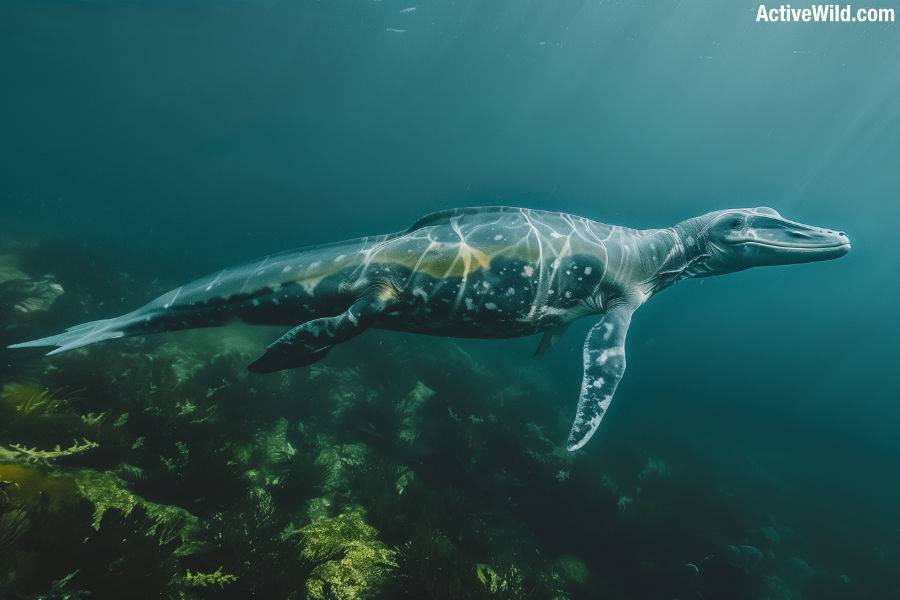
- Class of animal: Reptilia (Pliosaur)
- Family: Pliosauridae
- When it lived: Middle to Late Jurassic (about 166 to 155 million years ago)
- Where found: Europe (notably in England and France)
- Size: Up to 6.4 meters (21 feet) in length (some estimates suggest up to 10 meters / 33 feet)
The family Pliosauridae contained both long-necked and short-necked, large-headed species. The short-necked group is named Thalassophonea, and one of its best-known members is Liopleurodon.
Liopleurodon was a large pliosaur equipped with powerful jaws, with which it hunted large prey, including fish, squid, and other marine reptiles. It had a robust body with strong, paddle-like limbs that provided the swift acceleration required for an ambush predator.
This Jurassic apex predator likely had a well-developed sense of smell, as indicated by its large nasal openings, which would have helped it detect prey from a distance.
Megalodon

- Class of animal: Chondrichthyes (Cartilaginous fish)
- Family: Otodontidae
- When it lived: Early Miocene to Pliocene (about 23 to 3.6 million years ago)
- Where found: Worldwide (fossils found on every continent except Antarctica)
- Size: Estimates range from 15 to 18 meters (49 to 59 feet) in length
Otodus megalodon, usually known simply as Megalodon, is thought to have been the largest shark that ever lived.
Resembling a living shark, but larger, Megalodon had massive, serrated teeth measuring up to 18 cm (7 inches) in length. With a tremendously powerful bite force – possibly the greatest of any animal alive or extinct, even the shells of sea turtles would have posed no difficulty to Megalodon. Also on the menu would have been whales, seals, and sea turtles.
Megalodon inhabited warm, coastal waters around the world. Megalodons went extinct around one million years before the arrival of Homo habilis, an early ancestor of humans.
You can find out more about Megalodon on this page: Megalodon Facts
Mosasaurs

- Class of animal: Reptilia
- Family: Mosasauridae
- When it lived: Late Cretaceous (about 98 to 66 million years ago)
- Where found: Worldwide (fossils found in North America, Europe, Africa, South America, and Asia)
- Size: Ranged from 1 meter (3.3 feet) to over 17 meters (56 feet) in length, depending on the species
Following the extinction of the ichthyosaurs and pliosaurs, it was the turn of the Mosasaurs to dominate the oceans of the Late Cretaceous. These large, predatory marine reptiles belong to the reptile group Squamata, which is also home to lizards and snakes. They are thought to have evolved from small, coastal lizards, and may be related to monitor lizards.
A scientific study published in 2016 suggests Mosasaurs had forked tongues. (source)
The strong jaws of mosasaurs were lined with sharp teeth, enabling them to hunt a wide variety of prey, including fish, sharks, cephalopods, and even other marine reptiles. Their anatomy suggests they were fast and agile swimmers, capable of ambushing or pursuing their prey.
Mosasaurs are considered one of the top marine predators of their time, and their widespread fossil distribution highlights their success and adaptability in ancient marine ecosystems.
You can find out more about mosasaurs on this page: Mosasaur Facts
Mosasaurus

- Class of animal: Reptilia (Mosasaur)
- Family: Mosasauridae
- When it lived: Late Cretaceous (about 80 to 66 million years ago)
- Where found: Worldwide (notably in North America and Europe)
- Size: Up to 17 meters (56 feet) in length
Mosasaurus was one of the largest and most formidable mosasaurs, possessing a robust body, a long, powerful tail, and paddle-like limbs adapted for efficient swimming. It had an elongated head with strong jaws lined with numerous sharp teeth, designed for gripping and tearing prey.
Mosasaurus was an apex predator in its marine environment, preying on a variety of marine animals, including fish, sharks, cephalopods, and smaller marine reptiles. Its powerful build and predatory skills made it a dominant force in the Late Cretaceous oceans.
You can find out more about mosasaurus on this page: Mosasaurus Facts
Nothosaurs
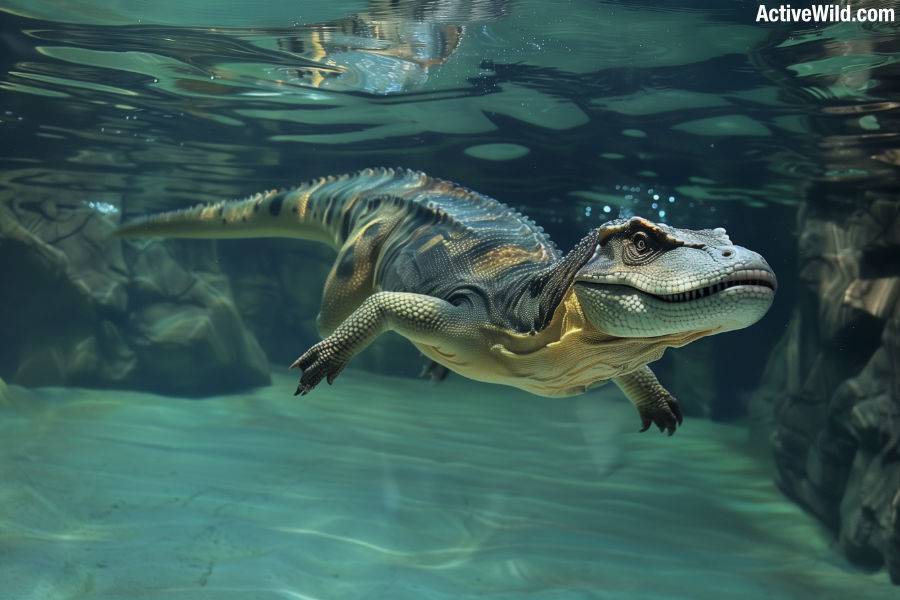
- Class of animal: Reptilia
- Family: Nothosauridae
- When it lived: Middle Triassic to Late Triassic (about 240 to 210 million years ago)
- Where found: Europe, Asia, and North Africa
- Size: Ranged from 3 to 4 meters (10 to 13 feet) in length
Nothosaurs were semi-aquatic reptiles with elongated bodies, long necks, and limbs adapted for both swimming and walking on land. They had webbed feet and a streamlined shape that allowed for efficient movement in water, but they could also move on land, similar to modern seals.
Nothosaurs had elongated jaws filled with sharp teeth, ideal for catching fish and other small marine animals. Their dual lifestyle and adaptability made them successful predators in both marine and coastal environments during the Triassic period.
Nothosaurus
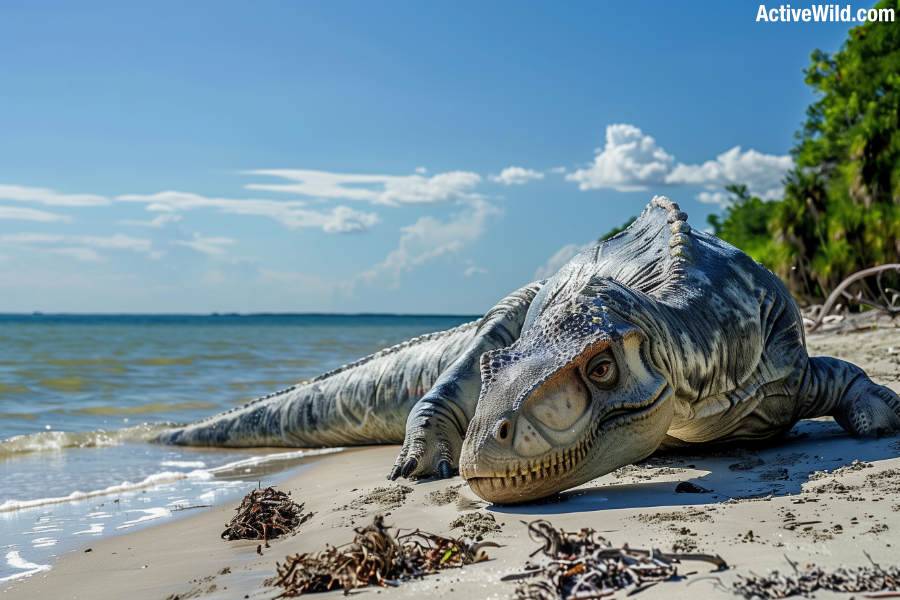
- Class of animal: Reptilia (Nothosaur)
- Family: Nothosauridae
- When it lived: Middle Triassic to Late Triassic (about 240 to 210 million years ago)
- Where found: Europe and Asia
- Size: Around 4 meters (13 feet) in length
Nothosaurus is the best-known type of nothosaur. This semi-aquatic Triassic predator had a streamlined body, long neck, and webbed limbs, and was semi-aquatic, being able to move both in the water and on land.
The elongated, crocodile-like jaws of Nothosaurus were filled with sharp, conical teeth, suitable for catching slippery prey such as fish and squid.
Nothosaurus had a lifestyle similar to that of modern seals, being capable of swimming efficiently in water while also being able to haul out onto land. Their fossils are often found in marine deposits, indicating that they spent a significant amount of time in the water, but they also likely basked and nested on land.
Opabinia

- Class of animal: Marrellomorpha (often debated) (Arthropod)
- Family: Opabiniidae
- When it lived: Middle Cambrian (about 505 million years ago)
- Where found: North America (notably in the Burgess Shale, Canada)
- Size: Approximately 7 centimeters (2.8 inches) in length
One of the earliest animals on this list of prehistoric ocean creatures, Opabinia was a marine arthropod that lived over 500 million years ago.
This small, soft-bodied marine animal is notable for its unusual appearance, with five eyes on stalks and a long, flexible proboscis with a claw-like structure at the end. This proboscis was likely used to grasp and manipulate food.
The body of Opabinia had lobes along its sides and a fan-shaped tail, suggesting it was a swimmer that moved through the water by undulating its body and lobes. Its unique anatomy has made it one of the most intriguing and iconic creatures from the Cambrian period.
Plesiosaurs
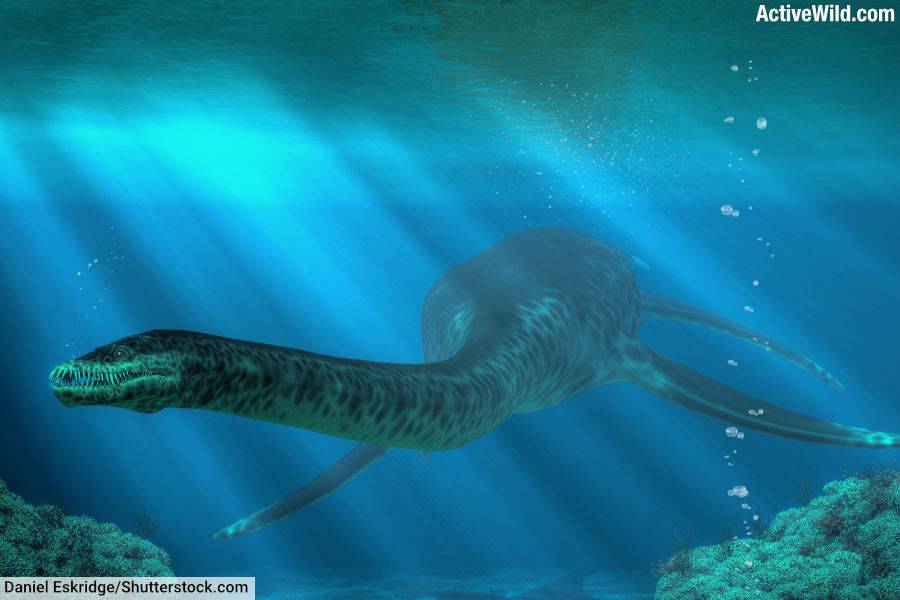
- Class of animal: Reptilia
- Family: Plesiosauridae (and other related families within Plesiosauria)
- When it lived: Late Triassic to Late Cretaceous (about 203 to 66 million years ago)
- Where found: Worldwide (fossils discovered on every continent)
- Size: Ranged from 2 to 15 meters (6.5 to 49 feet) in length, depending on the species
Plesiosaurs were large marine reptiles with broad bodies, short tails, and four long, paddle-like limbs that they used for propulsion in water. They were one of the most successful groups of prehistoric sea animals, living from the Late Triassic all the way up to the extinction event at the end of the Cretaceous Period in which the dinosaurs also became extinct.
There were two main groups of plesiosaurs: long-necked (plesiosauromorphs) and short-necked (pliosauromorphs). The long-necked plesiosaurs had elongated necks and small heads, which they likely used to catch small fish and other marine organisms.
The short-necked varieties had larger heads and powerful jaws, adapted for hunting larger prey.
Plesiosaurus
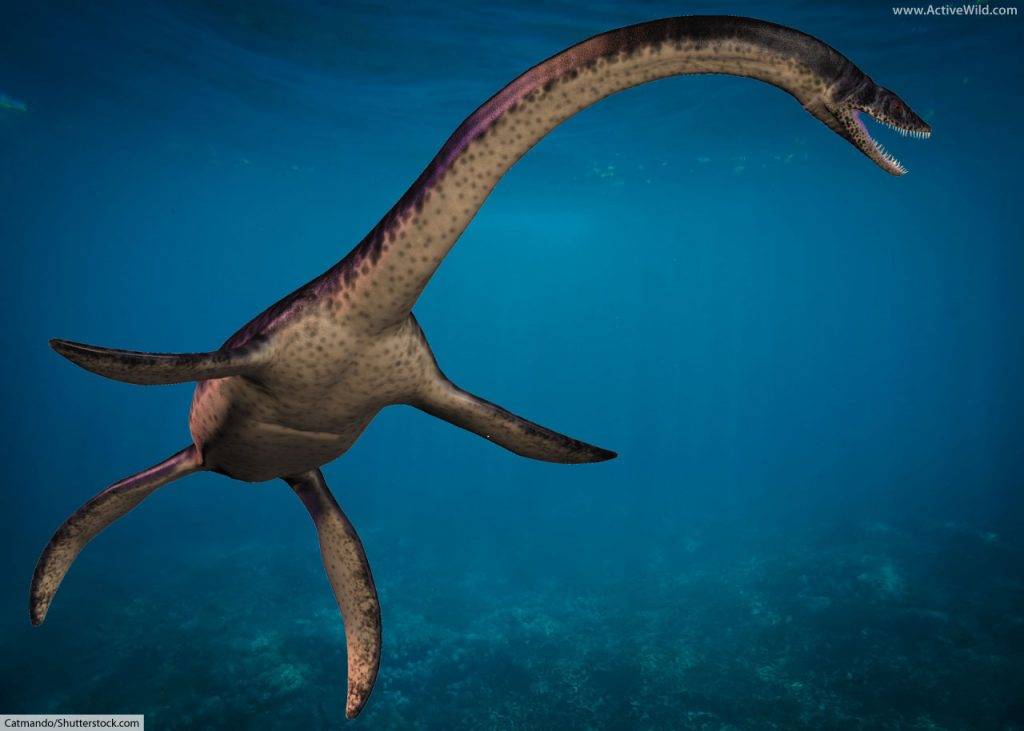
- Class of animal: Reptilia (Plesiosaur)
- Family: Plesiosauridae
- When it lived: Early Jurassic (about 201 to 183 million years ago)
- Where found: Europe (notably in England and Germany)
- Size: Approximately 3.5 to 4.5 meters (11 to 15 feet) in length
Plesiosaurus was a long-necked plesiosaur with a broad, flat body, a short tail, and four large, paddle-like limbs used for swimming. Its long, flexible neck and small head with sharp teeth were ideal adaptations for catching fish and other small marine creatures.
One theory on how Plesiosaurus moved through the water suggests that it used its four flippers in a coordinated manner similar to underwater “flying”. Another, earlier, theory proposes that all four flippers worked in a more synchronized, rowing-like motion to propel the large sea creature efficiently through the water.
Plesiosaurus was the first plesiosaur to be discovered.
Pliosaurs

- Class of animal: Reptilia
- Family: Pliosauridae
- When it lived: Early Jurassic to Late Cretaceous (about 201 to 80 million years ago)
- Where found: Worldwide (fossils found in North America, Europe, South America, and Australia)
- Size: Ranged from 4 to 15 meters (13 to 49 feet) in length, depending on the species
Pliosaurs were a group of plesiosaurs with short necks, large heads, powerful jaws filled with sharp teeth, and robust bodies. The hind flippers of pliosaurs were longer than the fore-flippers (in other types of plesiosaurs, the opposite is true).
These prehistoric ocean reptiles were formidable predators, capable of hunting large prey, including fish, squid, and other marine reptiles.
Two well-known examples of pliosaurs are Liopleurodon and Kronosaurus, both renowned for their large size and powerful jaws.
Pliosaurus
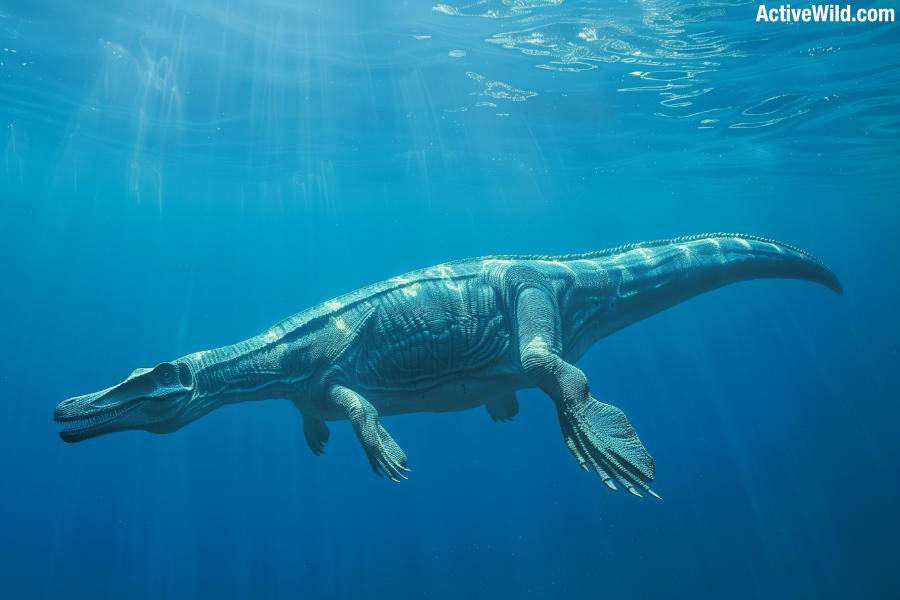
- Class of animal: Reptilia (Pliosaur)
- Family: Pliosauridae
- When it lived: Late Jurassic (about 155 to 145 million years ago)
- Where found: Europe (notably in England and France), with possible remains found in South America and Australia
- Size: Estimated up to 10 to 13 meters (33 to 43 feet) in length
Pliosaurus was a genus of large, predatory marine reptiles characterized by a robust body, relatively short neck, and an enormous head equipped with powerful jaws and large, conical teeth.
At the time of writing, six species of Pliosaurus are recognized. The first species to be named was Pliosaurus brachydeirus. It was named by English paleontologist Richard Owen, who also invented the term “dinosaur” to describe the now-famous group of prehistoric land animals.
Shastasaurus

- Class of animal: Reptilia (Ichthyosaur)
- Family: Shastasauridae
- When it lived: Late Triassic (about 215 to 210 million years ago)
- Where found: North America (notably in California and Nevada), with possible remains in China
- Size: Estimated up to 10 meters (33 feet) in length
Shastasaurus was one of the largest known ichthyosaurs, with a streamlined, dolphin-like body adapted for efficient swimming in the open ocean.
Unlike many other ichthyosaurs, Shastasaurus had a relatively short, blunt snout and lacked the typical elongated, conical teeth, suggesting it may have fed on soft-bodied prey like squid and fish using suction feeding.
Its large size and streamlined shape indicate that Shastasaurus was well-suited for deep diving and long-distance swimming.
Tylosaurus
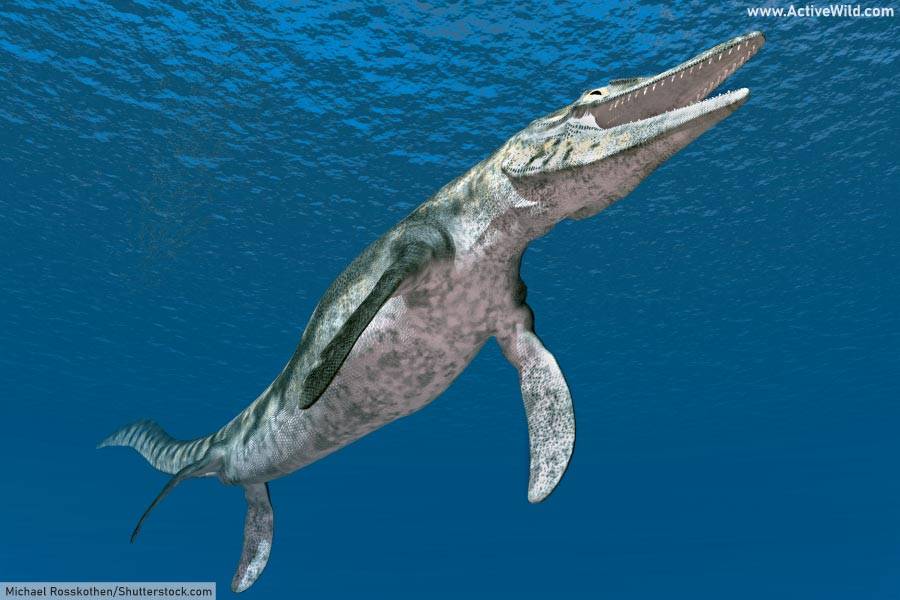
- Class of animal: Reptilia (Mosasaur)
- Family: Mosasauridae
- When it lived: Late Cretaceous (about 85 to 66 million years ago)
- Where found: North America (notably in the Western Interior Seaway)
- Size: Up to 14 meters (46 feet) in length
Tylosaurus was a large, predatory mosasaur with a long, streamlined body and powerful, paddle-like limbs adapted for swimming. It had an elongated head with a distinctive, bony protrusion on its snout, and its jaws were filled with sharp teeth, ideal for catching and holding onto prey.
Tylosaurus was an apex predator in its marine environment, preying on fish, sharks, smaller marine reptiles, and even seabirds. Its powerful swimming abilities and predatory skills made it one of the dominant marine sea animals of the Late Cretaceous period.
Xiphactinus
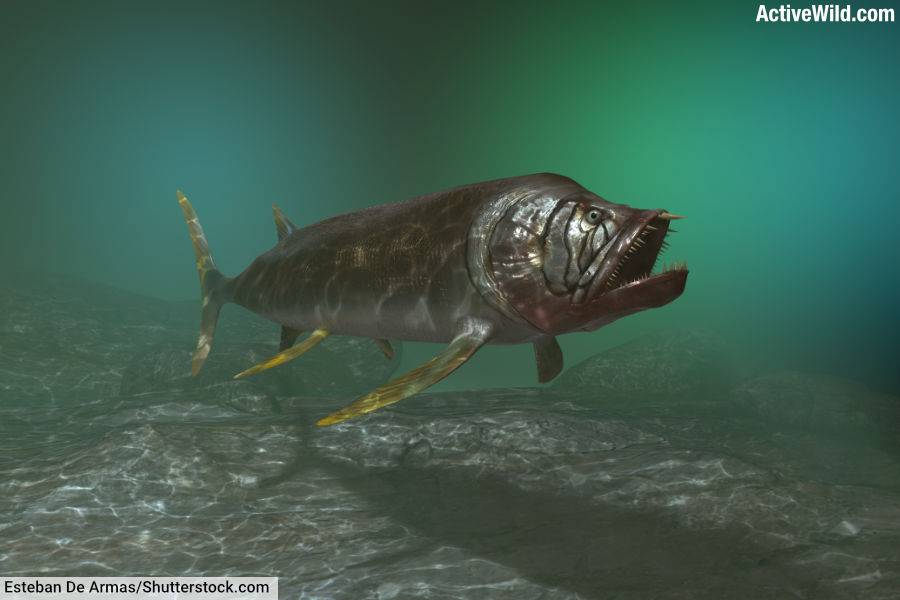
- Class of animal: Actinopterygii (Bony fish)
- Family: Ichthyodectidae
- When it lived: Late Cretaceous (about 112 to 66 million years ago)
- Where found: North America, Europe, and Australia (notably in the Western Interior Seaway of North America)
- Size: Up to 6 meters (20 feet) in length
Xiphactinus was a large, predatory bony fish known for its robust body, elongated, streamlined shape, and large, fang-like teeth. It had a strong, upturned lower jaw, which gave it a formidable appearance. Its body shape resembled that of a modern tarpon
Xiphactinus was an apex predator in its marine environment, capable of fast swimming and likely ambushing or chasing down prey, which included smaller fish and other marine animals. Several fossils of Xiphactinus have smaller fish preserved within their stomachs.
Discover More With Active Wild
Visit our main dinosaur page to discover everything you ever wanted to know about dinosaurs: Dinosaurs – The Complete Guide
You can see more prehistoric animals on this page: Prehistoric Animals
Visit our main animals page for links to animal information and a complete guide to the animal kingdom: Animals
The post Prehistoric Sea Creatures With Pictures & Interesting Facts appeared first on Active Wild.